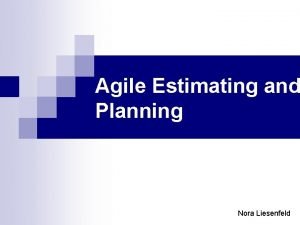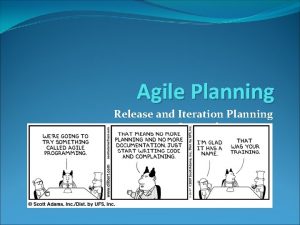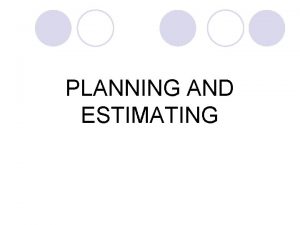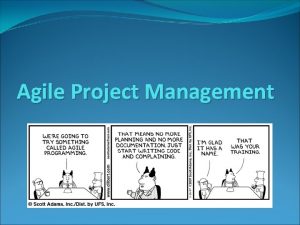Agile Estimating and Planning Nora Liesenfeld Agile Estimating










- Slides: 10

Agile Estimating and Planning Nora Liesenfeld

Agile Estimating and Planning Author: Mike Cohn Title: Agile Estimating and Planning 08. 05. 2008 Nora Liesenfeld TU München 2

Agile Estimating and Planning 1. 2. 3. 4. The Problem and the Goal Agile Estimating Agile Planning Why Agile Planning Works 08. 05. 2008 Nora Liesenfeld TU München 3

The Problem and the Goal “Traditional project management assumes that events effecting the project are predictable and that tools and activities are well understood. In addition, with traditional project management, once a phase is complete, it is assumed that it will not be revisited. ” Figure: Waterfall Model, from PMWorld. Today (Vol. IX, Issue V), Page 1 08. 05. 2008 Nora Liesenfeld TU München 4

Traditional planning fails Nearly two-thirds of projects significantly overrun their cost estimates (Lederer and Prasad 1992) n 64% of the features included in products are rarely or never used (Johnson 2002) n The average project exceeds its schedule by 100% (Standish 2001) n 08. 05. 2008 Nora Liesenfeld TU München 5

Why does traditional Planning fail? n Planning by Activity rather than feature Activities don‘t finish early ¨ Lateness is passed down schedule ¨ Activities are not independant ¨ n n Multitasking causes further delays Features are not developed by priority We ignore uncertainty Estimates become Commitments 08. 05. 2008 Nora Liesenfeld TU München 6

Why do we plan? Planning: n n n Reduces risk Reduces uncertainty Supports decision making Establishes trust Conveys information 08. 05. 2008 Nora Liesenfeld TU München 7

Agile Estimating and Planning Project Management is a “highly iterative and incremental process, where developers and project stakeholders actively work together to understand the domain, identify what needs to be built, and prioritize functionality. ” Figure: Agile Development Model, from PMWorld. Today (Vol. IX, Issue V), Page 3 08. 05. 2008 Nora Liesenfeld TU München 8

Agile Estimating and Planning 1. 2. 3. 4. The Problem and the Goal Agile Estimating Agile Planning Why Agile Planning Works 08. 05. 2008 Nora Liesenfeld TU München 9

Estimating Techniques Most common Techniques for estimating size: n Expert Opinion n Analogy n Disaggregation Best is a combination of the 3 most common Techniques → Planning Poker 08. 05. 2008 Nora Liesenfeld TU München 11



















